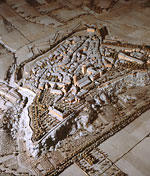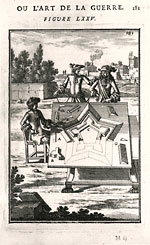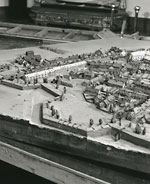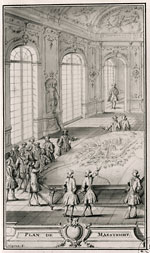Fine Maps
French Models

This model of Embrun was built in 1701 at the beginning of the War of Spanish Succession. Some of Louis XIV’s models were re-painted a uniform military gray as part of a misguided early twentieth-century restoration effort. Credit: A. Lonchampt, Centre des Monuments Nationaux, ALC 80/545.

Model building as depicted by the famous seventeenth-century French military theoretician, Alain Manesson Mallet. Credit: Thomas Fisher Rare Book Library, University of Toronto.

Side view of a typical model table showing the plank frame that was used to simulate large changes in the surface topography. A final layer of plaster covers the planks and was molded and colored to represent more subtle details in the landscape. Credit: Library and Archives Canada, C-14449.

The king and his advisors consult the model of Maestricht in the Grande Galerie of the Louvre in this 1753 print. The French captured the city from the Dutch in 1673 and again in 1748. Credit: Bibliothèque de l’Arsenal, Paris, B92/113.
Louis XIV kept his “princely toys” locked away in the Louvre; Louis XV continued to augment the collection and appointed a curator; and Louis XVI ordered it transferred to new quarters at the Hôtel des Invalides in Paris, where it remains to this day. When the Paris Universal Exhibition opened in 1867, the model gallery became available to the public. By 1927, when it was obvious that several models had been lost or damaged, the French government took the unprecedented move of protecting the collection by declaring it an historic monument.
Today, Louis XIV’s collection is unique both in terms of its extent and its attention to detail. The collection stands as a testament to the ingenuity of early French mapmakers and their tremendous efforts to render a true likeness of French military might for their king. Gazing on these once vital tools of conquest, it is easy to be transfixed by the marvelous aerial views they offer of mighty fortifications and humble homes. Just as the realism helped Louis XIV envision the wonders of his kingdom, we too can marvel at these royal treasures and, with a little imagination, walk the same streets where kings and commoners alike once strode.
Jeffrey Murray is a former senior archivist with Library and Archives Canada, Ottawa, Canada, and author of Terra Nostra: The Stories Behind Canada’s Maps, 1550-1950 (Montreal, McGill-Queen’s University Press, 2006).












